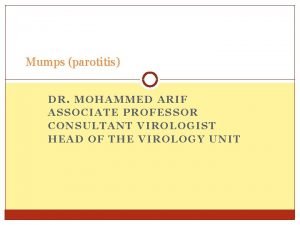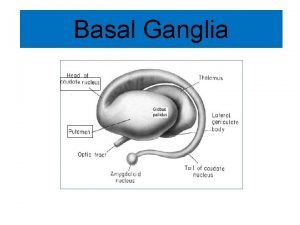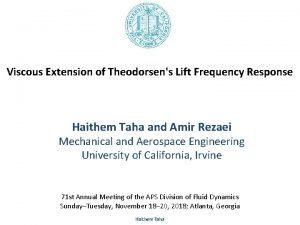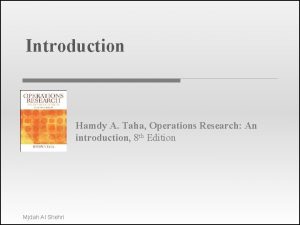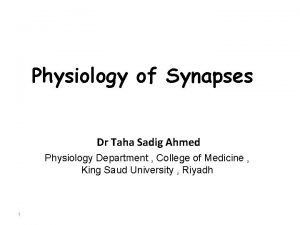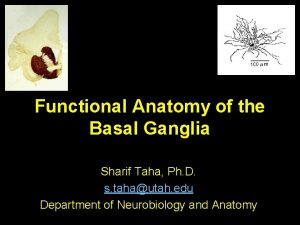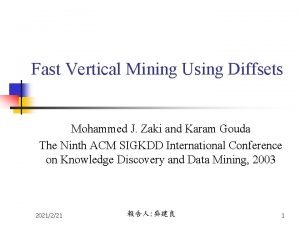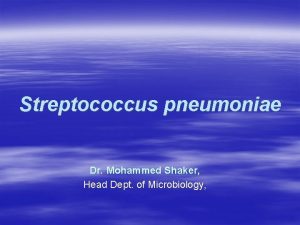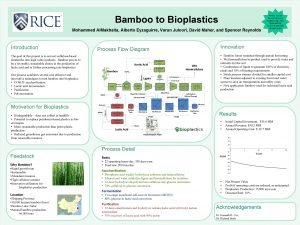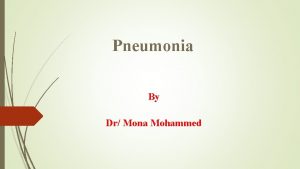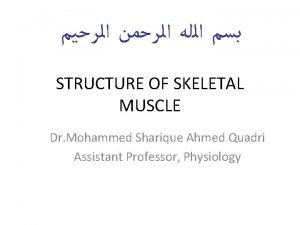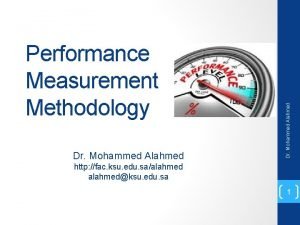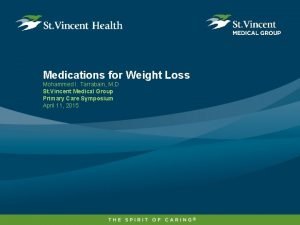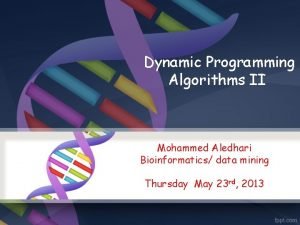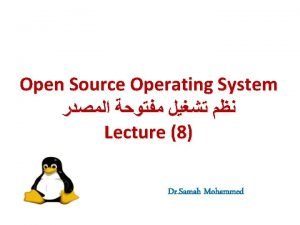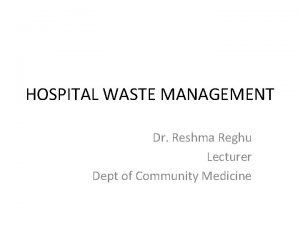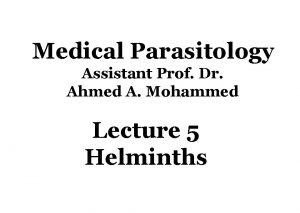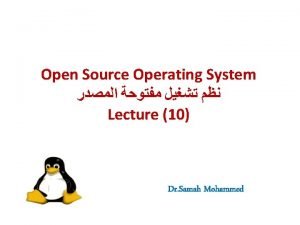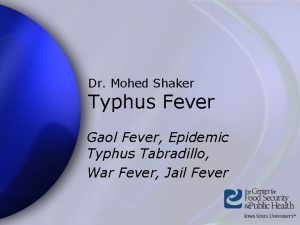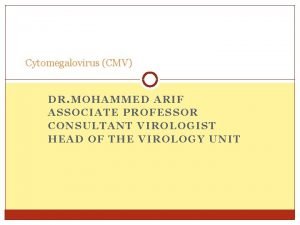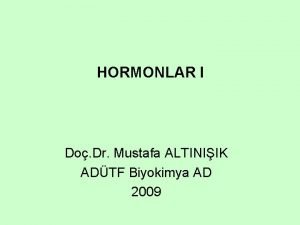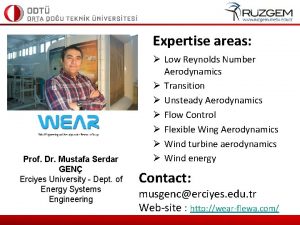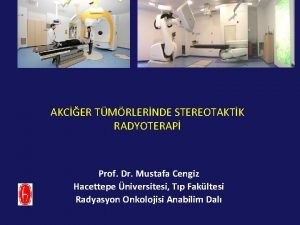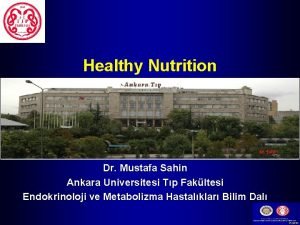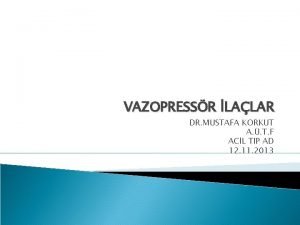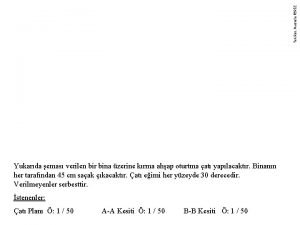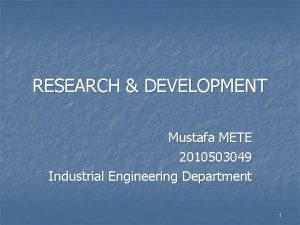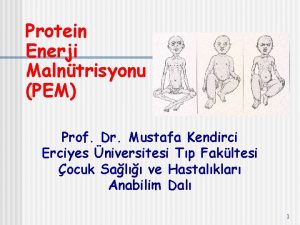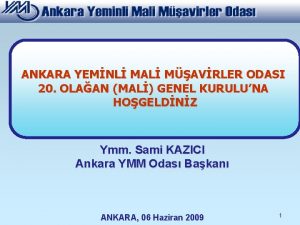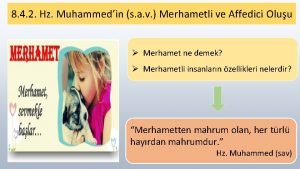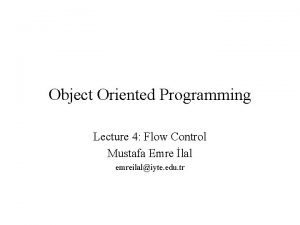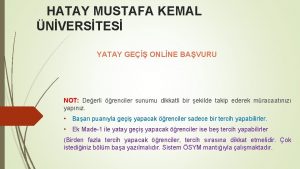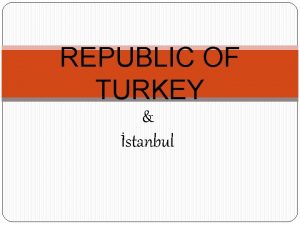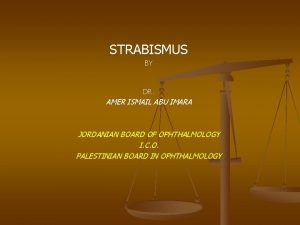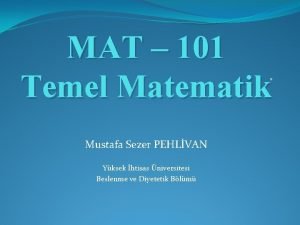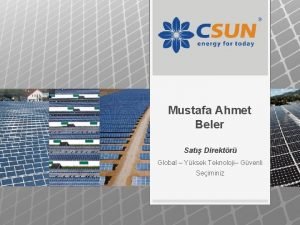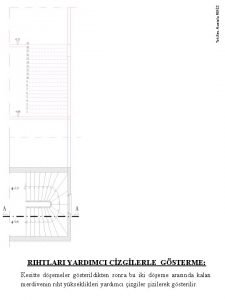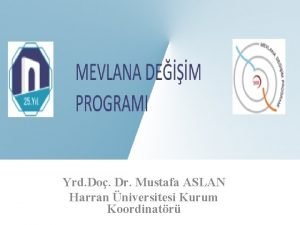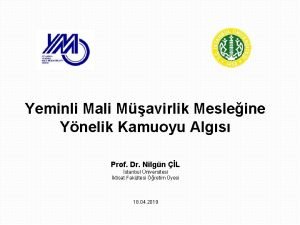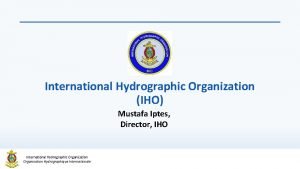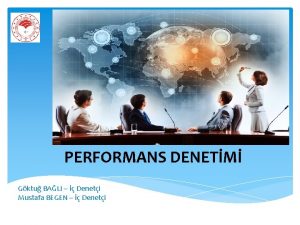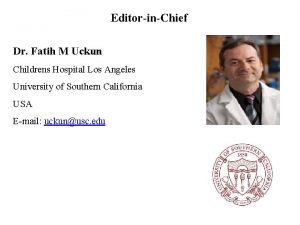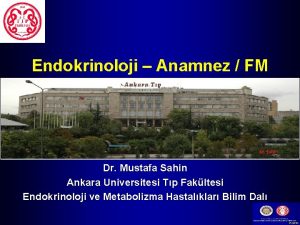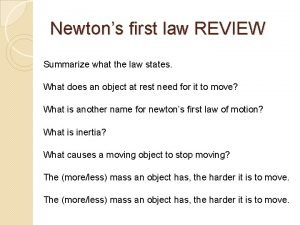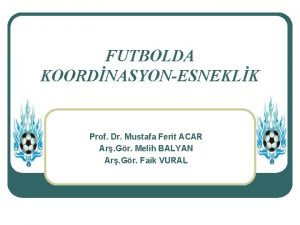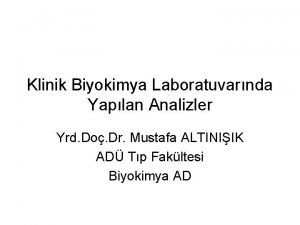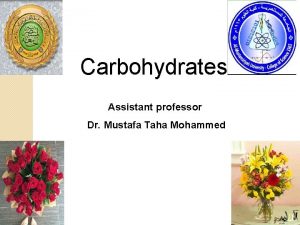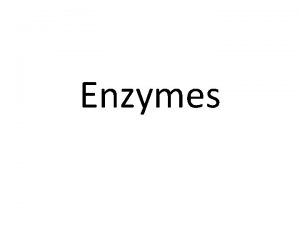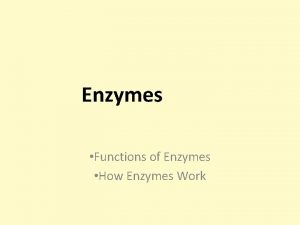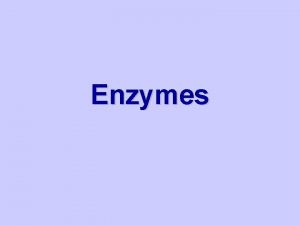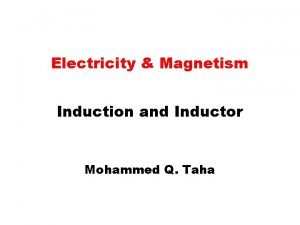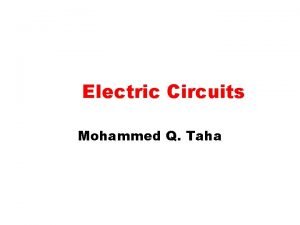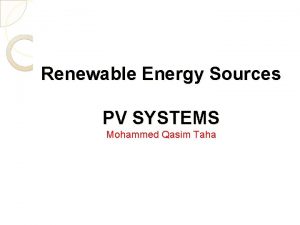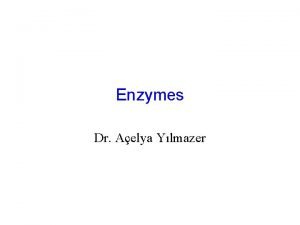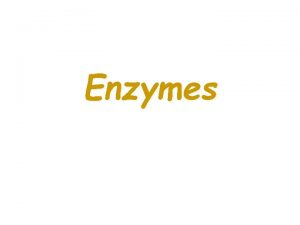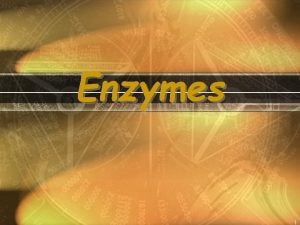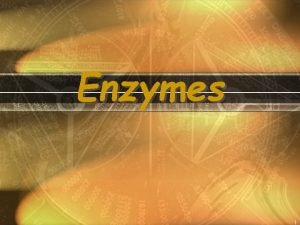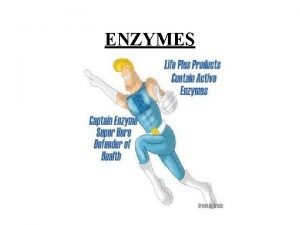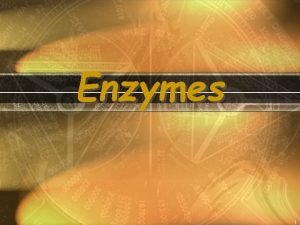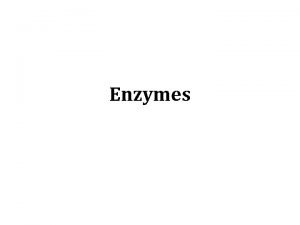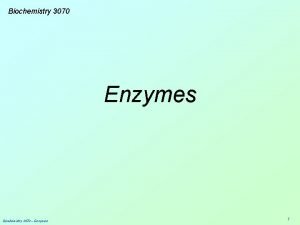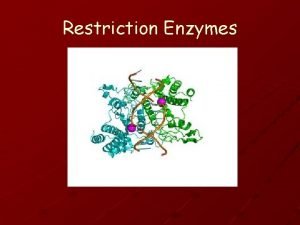Enzymes Assistant professor Dr Mustafa Taha Mohammed Enzymes





































































































- Slides: 101

Enzymes Assistant professor Dr. Mustafa Taha Mohammed

Enzymes Enzyme Action Factors Affecting Enzyme Action Enzyme Inhibition 2

ENZYMES A protein with catalytic properties due to its power of specific activation

Enzyme structure • Enzymes are proteins • They have a globular shape • A complex 3 -D structure Human pancreatic amylase

What Are Enzymes? • Most enzymes are Proteins (tertiary and quaternary structures) • Act as Catalyst to accelerates a reaction • Not permanently changed in the process 5

• • • Enzymes An enzyme is a biological catalyst The pockets formed by tertiary and quaternary structure can hold specific substances (SUBSTRATES). These pockets are called ACTIVE SITES. When all the proper substrates are nestled in a particular enzyme's active sites, the enzyme can cause them to react quickly Once the reaction is complete, the enzyme releases the finished products and goes back to work on more substrate.

What is an enzyme? • Almost all enzymes are proteins that act as biological catalysts. • A catalyst speeds up chemical reactions. Enzymes speed up biological chemical reactions. • Enzymes are highly specific to a type of reaction. • Enzymes must maintain their specific shape in order to function. Any alteration in the primary, secondary, tertiary, or quaternary forms of the enzyme are detrimental.

Function of enzymes Enzymes have many jobs. They: • Break down nutrients into useable molecules. • Store and release energy (ATP). • Create larger molecules from smaller ones ) • Coordinate biological reactions between different systems in an organism. )

Enzymes • • Catalysts for biological reactions Most are proteins Lower the activation energy Increase the rate of reaction Activity lost if denatured May be simple proteins May contain cofactors such as metal ions or organic (vitamins) 9

Enzyme Catalyzed Reactions • When a substrate (S) fits properly in an active site, an enzyme-substrate (ES) complex is formed: E + S ES • Within the active site of the ES complex, the reaction occurs to convert substrate to product (P): ES E + P • The products are then released, allowing another substrate molecule to bind the enzyme - this cycle can be repeated millions (or even more) times per minute • The overall reaction for the conversion of substrate to product can be written as follows: E + S E + P

Enzymes • Are specific for what they will catalyze • Are Reusable • End in –ase -Sucrase -Lactase -Maltase 11

A E B 12

How do enzymes Work? Enzymes work by weakening bonds which lowers activation energy 13

Enzymes Without Enzyme With Enzyme Free Energy Free energy of activation Reactants Products Progress of the reaction 14

Reaction pathway

HOW ENZYMES WORK • Enzymes are ORGANIC CATALYSTS. A CATALYST is anything that speeds up a chemical reaction that is occurring slowly. How does a catalyst work? • The explanation of what happens lies in the fact that most chemical reactions that RELEASE ENERGY (exothermic reactions) require an INPUT of some energy to get them going. The initial input of energy is called the ACTIVATION ENERGY

An enzyme controlled pathway • Enzyme controlled reactions proceed 108 to 1011 times faster than corresponding non-enzymic reactions.

The substrate • The substrate of an enzyme are the reactants that are activated by the enzyme • Enzymes are specific to their substrates • The specificity is determined by the active site

Active Site • A restricted region of an enzyme molecule which binds to the substrate Active Site Substrate Enzyme 19

Enzyme-Substrate Complex The substance (reactant) an enzyme acts on is the substrate Substrate Joins Enzyme 20

Making reactions go faster • Increasing the temperature make molecules move faster • Biological systems are very sensitive to temperature changes. • Enzymes can increase the rate of reactions without increasing the temperature. • They do this by lowering the activation energy. • They create a new reaction pathway “a short cut”

Chemical reactions • Chemical reactions need an initial input of energy = THE ACTIVATION ENERGY • During this part of the reaction the molecules are said to be in a transition state.

Enzymes as Biological Catalysts • Enzymes are proteins that increase the rate of reaction by lowering the energy of activation • They catalyze nearly all the chemical reactions taking place in the cells of the body • Enzymes have unique three-dimensional shapes that fit the shapes of reactants (substrates)

Enzyme Activity The properties of enzymes related to their tertiary structure. The effects of change in temperature, p. H, substrate concentration, and competitive and non-competitive inhibition on the rate of enzyme action

The substrate • The substrate of an enzyme are the reactants that are activated by the enzyme • Enzymes are specific to their substrates • The specificity is determined by the active site

The active site • One part of an enzyme, the active site, is particularly important • The shape and the chemical environment inside the active site permits a chemical reaction to proceed more easily

Making reactions go faster • Increasing the temperature make molecules move faster • Biological systems are very sensitive to temperature changes. • Enzymes can increase the rate of reactions without increasing the temperature. • They do this by lowering the activation energy. • They create a new reaction pathway “a ”

What Affects Enzyme Activity? • Three factors: 1. Environmental Conditions 2. Cofactors and Coenzymes 3. Enzyme Inhibitors 28

Classification of Enzymes • Enzymes are classified according to the type of reaction they catalyze: Class § Oxidoreductases § Transferases § Hydrolases § Lyases § Isomerases § Ligases Reactions catalyzed Oxidation-reduction Transfer groups of atoms Hydrolysis Add atoms/remove atoms to/from a double bond Rearrange atoms Use ATP to combine molecules

Examples of Classification of Enzymes • Oxidoreductoases oxidases - oxidize , reductases – reduce • Transferases transaminases – transfer amino groups kinases – transfer phosphate groups • Hydrolases proteases - hydrolyze peptide bonds lipases – hydrolyze lipid ester bonds • Lyases carboxylases – add CO 2 hydrolases – add H 2 O 30

Learning Check E 1 Match the type of reaction with the enzymes: (1) aminase (2) dehydrogenase (3) Isomerase (4) synthetase A. B. C. D. Converts a cis-fatty acid to trans. Removes 2 H atoms to form double bond Combine two molecules using ATP Adds NH 3 31

Solution E 1 Match the type of reaction with the enzymes: (1) aminase (2) dehydrogenase (3) Isomerase (4) synthetase A. 3 Converts a cis-fatty acid to trans. B. 2 Removes 2 H atoms to form double bond C. 4 Combine two molecules using ATP D. 1 Adds NH 3 32

Name of Enzymes • End in –ase • Identifies a reacting substance sucrase – reacts sucrose lipase - reacts lipid • Describes function of enzyme oxidase – catalyzes oxidation hydrolase – catalyzes hydrolysis • Common names of digestion enzymes still use –in pepsin, trypsin 33

Cofactors • An additional nonprotein molecule that is needed by some enzymes to help the reaction • Tightly bound cofactors are called prosthetic groups • Cofactors that are bound and released easily are called coenzymes • Many vitamins are coenzymes Nitrogenase enzyme with Fe, Mo and ADP cofactors © )

Enzyme cofactors cont. • An enzyme that is bonded to its cofactor is called a holoenzyme. • An enzyme that requires a cofactor, but is not bonded to the cofactor is called an apoenzyme. Apoenzymes are not active until they are complexed with the appropriate cofactor.

Enzyme cofactors • A cofactor is a substance that is not a protein that must bind to the enzyme in order for the enzyme to work. • • A cofactor can be of organic origin. An organic cofactor is called a coenzyme. • • Cofactors are not permanently bonded. Permanently bonded cofactors are called prosthetic groups.

Enzyme action overview • Enzymes are large molecules that have a small section dedicated to a specific reaction. This section is called the active site. • • The active site reacts with the desired substance, called the substrate • The substrate may need an environment different from the mostly neutral environment of the cell in order to react. Thus, the active site can be more acidic or basic, or provide opportunities for different types of bonding to occur, depending on what type of side chains are present on the amino acids of the active site.

Enzyme action theories • Lock and Key: This theory, postulated by Emil Fischer in 1894, proposed that an enzyme is “structurally complementary to their substrates” and thus fit together perfectly like a lock and key. This theory formed the basis of most of the ideas of how enzymes work, but is not completely correct. . ,

Lock-and-Key Model • In the lock-and-key model of enzyme action: - the active site has a rigid shape - only substrates with the matching shape can fit - the substrate is a key that fits the lock of the active site • This is an older model, however, and does not work for all enzymes

Enzyme Action: Lock and Key Model • An enzyme binds a substrate in a region called the active site • Only certain substrates can fit the active site • Amino acid R groups in the active site help substrate bind • Enzyme-substrate complex forms • Substrate reacts to form product • Product is released 40

41

Lock and Key Model P + S P E + S ES complex E + P 42

The Lock and Key Hypothesis • Fit between the substrate and the active site of the enzyme is exact • Like a key fits into a lock very precisely • The key is analogous to the enzyme and the substrate analogous to the lock. • Temporary structure called the enzyme-substrate complex formed • Products have a different shape from the substrate • Once formed, they are released from the active site • Leaving it free to become attached to another substrate

The Lock and Key Hypothesis S E Enzym e. P substr ate P compl Reaction ex coordinate Enzyme may be used again

Enzyme Action: Induced Fit Model • Enzyme structure flexible, not rigid • Enzyme and active site adjust shape to bind substrate • Increases range of substrate specificity • Shape changes also improve catalysis during reaction 45

Induced Fit • A change in the shape of an enzyme’s active site • Induced by the substrate 46

Induced Fit • A change in the configuration of an enzyme’s active site (H+ and ionic bonds are involved). • Induced by the substrate Active Site Enzyme induced fit 47

Enzyme Action: Induced Fit Model P S S P E + S ES complex E + P 48

Induced Fit Model • In the induced-fit model of enzyme action: - the active site is flexible, not rigid - the shapes of the enzyme, active site, and substrate adjust to maximumize the fit, which improves catalysis - there is a greater range of substrate specificity • This model is more consistent with a wider range of enzymes

Learning Check E 2 A. The active site is (1) the enzyme (2) a section of the enzyme (3) the substrate B. In the induced fit model, the shape of the enzyme when substrate binds (1) Stays the same (2) adapts to the shape of the substrate 50

Solution E 2 A. The active site is (2) a section of the enzyme B. In the induced fit model, the shape of the enzyme when substrate binds (2) adapts to the shape of the substrate 51

2. Cofactors and Coenzymes • Inorganic substances (zinc, iron) and vitamins (respectively) are sometimes need for proper enzymatic activity • Example: Iron must be present in the quaternary structure - hemoglobin in order for it to pick up oxygen. 52

Coenzyme reactions • Coenzymes help transfer a functional group to a molecule. • For example, coenzyme A (Co. A) is converted to acetyl. Co. A in the mitochondria using pyruvate and NAD • Acetyl-Co. A can then be used to transfer an acetyl group (CH 3 CO) to aid in fatty acid synthesis.

1. Environmental Conditions 1. Extreme Temperature are the most dangerous - high temps may denature (unfold) the enzyme. 2. p. H (most like 6 - 8 p. H near neutral) 3. Ionic concentration (salt ions) 54

Factors that affect enzyme action Enzymes are mostly affected by changes in temperature and p. H. • Too high of a temperature will denature the protein components, rendering the enzyme useless. • p. H ranges outside of the optimal range will protonate or deprotonate the side chains of the amino acids involved in the enzyme’s function which may make them incapable of catalyzing a reaction.

Factors Affecting Enzyme Action: Temperature • Little activity at low temperature • Rate increases with temperature • Most active at optimum temperatures (usually 37°C in humans) • Activity lost with denaturation at high temperatures 56

The effect of temperature • For most enzymes the optimum temperature is about 30°C • Many are a lot lower, cold water fish will die at 30°C because their enzymes denature • A few bacteria have enzymes that can withstand very high temperatures up to 100°C • Most enzymes however are fully denatured at 70°C

Factors Affecting Enzyme Action Optimum temperature Reaction Rate Low High Temperature 58

Temperature and Enzyme Activity • Enzymes are most active at an optimum temperature (usually 37°C in humans) • They show little activity at low temperatures • Activity is lost at high temperatures as denaturation occurs

Factors Affecting Enzyme Action: Substrate Concentration • Increasing substrate concentration increases the rate of reaction (enzyme concentration is constant) • Maximum activity reached when all of enzyme combines with substrate 60

Substrate concentration: Non-enzymic reactions Reactio n velocity Substrate concentration • The increase in velocity is proportional to the substrate concentration

Substrate concentration: Enzymic reactions Vmax Reaction velocity Substrate concentration • Faster reaction but it reaches a saturation point when all the enzyme molecules are occupied. • If you alter the concentration of the enzyme then Vmax will change too.

Substrate Concentration and Reaction Rate • The rate of reaction increases as substrate concentration increases (at constant enzyme concentration) • Maximum activity occurs when the enzyme is saturated (when all enzymes are binding substrate) • The relationship between reaction rate and substrate concentration is exponential, and asymptotes (levels off) when the enzyme is saturated

Factors Affecting Enzyme Action Maximum activity Reaction Rate substrate concentration 64

Factors Affecting Enzyme Action: p. H • • • Maximum activity at optimum p. H R groups of amino acids have proper charge Tertiary structure of enzyme is correct Narrow range of activity Most lose activity in low or high p. H 65

Factors Affecting Enzyme Action Reaction Rate Optimum p. H 3 5 7 9 11 p. H 66

p. H and Enzyme Activity • Enzymes are most active at optimum p. H • Amino acids with acidic or basic side-chains have the proper charges when the p. H is optimum • Activity is lost at low or high p. H as tertiary structure is disrupted

Enzyme Concentration and Reaction Rate • The rate of reaction increases as enzyme concentration increases (at constant substrate concentration) • At higher enzyme concentrations, more enzymes are available to catalyze the reaction (more reactions at once) • There is a linear relationship between reaction rate and enzyme concentration (at constant substrate concentration)

Factors that affect enzyme action • Enzymes that can be activated will be affected by the amount of activator or inhibitor attached to its allosteric site. An abundance of an allosteric activator will convert more enzymes to the active form creating more product. • Enzymes that are part of a metabolic pathway may be inhibited by the very product they create. This is called feedback inhibition. The amount of product generated will dictate the number of enzymes used or activated in that specific process.

Factors that affect enzyme action Enzymes are also affected by the concentration of substrate, cofactors and inhibitors, as well as allosteric regulation and feedback inhibition. (Campbell & Reece, 2002, pp. 99 -102) • The concentration of substrate will dictate how many enzymes can react. Too much substrate will slow the process until more enzyme can be made. • The availability of cofactors also dictate enzyme action. Too little cofactors will slow enzyme action until more cofactors are added. • An influx of competitive or non-competitive inhibitors will not necessarily slow the enzyme process, but will slow the amount of desired product.

Learning Check E 3 Sucrase has an optimum temperature of 37°C and an optimum p. H of 6. 2. Determine the effect of the following on its rate of reaction (1) no change (2) increase (3) decrease A. Increasing the concentration of sucrose B. Changing the p. H to 4 C. Running the reaction at 70°C 71

Solution E 3 Sucrase has an optimum temperature of 37°C and an optimum p. H of 6. 2. Determine the effect of the following on its rate of reaction (1) no change (2) increase (3) decrease A. 2, 1 Increasing the concentration of sucrose B. 3 Changing the p. H to 4 C. 3 Running the reaction at 70°C 72

Enzyme Inhibition Inhibitors • cause a loss of catalytic activity • Change the protein structure of an enzyme • May be competitive or noncompetitive • Some effects are irreversible 73

74

Two examples of Enzyme Inhibitors a. Competitive inhibitors: are chemicals that resemble an enzyme’s normal substrate and compete with it for the active site Substrate Enzyme Competitive inhibitor 75

Inhibitors b. Noncompetitive inhibitors: Inhibitors that do not enter the active site, site but bind to another part of the enzyme causing the enzyme to change its shape, shape which in turn alters the active site Substrate active site altered Enzyme Noncompetitive Inhibitor 76

Enzyme Inhibitors • Inhibitors (I) are molecules that cause a loss of enzyme activity • They prevent substrates from fitting into the active site of the enzyme: E + S E + P E + I EI no P formed

Competitive Inhibition A competitive inhibitor • Has a structure similar to substrate • Occupies active site • Competes with substrate for active site • Has effect reversed by increasing substrate concentration 78

Reversible Inhibitors (Competitive Inhibition) • A reversible inhibitor goes on and off, allowing the enzyme to regain activity when the inhibitor leaves • A competitive inhibitor is reversible and has a structure like the substrate - it competes with the substrate for the active site - its effect is reversed by increasing substrate concentration

Noncompetitive Inhibition A noncompetitive inhibitor • Does not have a structure like substrate • Binds to the enzyme but not active site • Changes the shape of enzyme and active site • Substrate cannot fit altered active site • No reaction occurs • Effect is not reversed by adding substrate 80

Reversible Inhibitors (Noncompetitive Inhibition) • A noncompetitive inhibitor has a structure that is different than that of the substrate - it binds to an allosteric site rather than to the active site - it distorts the shape of the enzyme, which alters the shape of the active site and prevents the binding of the substrate • The effect can not be reversed by adding more substrate

Learning Check E 4 Identify each statement as describing an inhibitor that is (1) Competitive (2) Noncompetitive A. Increasing substrate reverses inhibition B. Binds to enzyme, not active site C. Structure is similar to substrate D. Inhibition is not reversed with substrate 82

Solution E 4 Identify each statement as describing an inhibitor that is (1) Competitive (2) Noncompetitive A. B. C. D. 1 2 Increasing substrate reverses inhibition Binds to enzyme, not active site Structure is similar to substrate Inhibition is not reversed with substrate 83

The switch: Allosteric inhibition Allosteric means “other site” Active site E Allosteric site

End point inhibition • The first step (controlled by e. A) is often controlled by the end product (F) • Therefore negative feedback is possible A e. A B e. B C e. C D e. D E e. F F Inhibition • The end products are controlling their own rate of production • There is no build up of intermediates (B, C, D and E)

The allosteric site the enzyme “onoff” switch Active site E Allosteri c site empty Substrat e fits into the active The inhibitor site molecule is absent Conformational change Substrate cannot fit into the active site E Inhibitor molecule is present Inhibitor fits into allosteric site

Switching off • These enzymes have two receptor sites • One site fits the substrate like other enzymes • The other site fits an inhibitor molecule Substrate cannot fit into the active site Inhibitor molecule Inhibitor fits into allosteric site

Isoenzymes • Isoenzymes are different forms of an enzyme that catalyze the same reaction in different tissues in the body - they have slight variations in the amino acid sequences of the subunits of their quaternary structure • For example, lactate dehydrogenase (LDH), which converts lactate to pyruvate, consists of five isoenzymes

89

Main Tissue Distribution of Enzymes AST liver, myocard ALT liver LD not specific CK myocard, muscles GMT liver ALP biliary tract, bones ACP prostate AMS pancreas LPS pancreas CHS liver 90

Intracellular Location of Enzymes Intracellular Location Enzymes Cytoplasm LD, ALT, 30 % AST Mitochondria 70 % AST Golgi complex, ER CHS, AMS Lysosome ACP Membrane GMT, ALP 91

Enzymes of Clinical Significance Enzyme Source of blood elevation ALT hepatopathy AST MI, hepatopathy GMT hepatopathy (alcohol, drugs) ALP biliary tract diseases, bone diseases ACP prostatic cancer CK MI (CK-MB), muscle diseases AMS pancreatitis LPS pancreatitis CHS hepatopathy (alcohol, drugs) – decreased 92

Enzymatic antioxidant 1. superoxide dismutase (SOD) SOD 2 O 2·⁻+ 2 H+ H 2 O 2 + O 2 SOD is present in essentially every cell in the body which actually represented by a group of metalloenzymes with various prosthetic groups. SOD appears in three forms: a) Cu-Zn SOD: in the cytoplasm with two subunits b) Mn-SOD: in the mitochondrion c) Cu-SOD: extracellular SOD This is the first line of defence to protect cells from the injurious effects of superoxide.

Enzymatic antioxidant 2. catalase, CAT catalase 2 H 2 O 2 2 H 2 O + O 2 Catalase, iron dependent enzyme, is present in all body organs being especially concentrated in the liver and erythrocytes. The brain, heart and skeletal muscle contains only low amounts.

Enzymatic antioxidant 3. glutathione peroxidase, GPx ROOH+ 2 GSH ROH+ GSSG + H 2 O GPx is a selenium-dependent enzyme. The entire process is driven by energy production at the cellular level, which involves proper thyroid hormone levels, healthy mitochondrial function, and an active pentosephosphate metabolic pathway.

Application of Enzymatic antioxidant 1. superoxide dismutase (SOD) - essential in skin to generate fibroblasts. - Play important role to prevent the development of Leu Gehrig`s disease. - Used for treatment of inflammatory diseases, burn injuries, prostate problems, arthritis and corneal ulcer.

Application of Enzymatic antioxidant - Help carry nitric oxide into hair follicles (nitric oxide relaxes the blood vessels and allow more blood to circulate to their follicles and SOD helps to remove free radicals).

Application of Enzymatic antioxidant 2. catalase, CAT - Used in the food industry for removing hydrogen peroxide from milk prior to cheese production. - Used in the food wrappers it prevent food from oxidation. - Several mask treatment combine the enzyme with hydrogen peroxide.

Application of Enzymatic antioxidant 3. glutathione peroxidase, GPx The main role of glutathione is immune system boosters.

Clinical applications of antioxidant enzymes • • • 1. Chronic Inflammation. 2. Acute Inflammation. 3. Respiratory Diseases. 4. Diseases of the Eye. 5. Shock Related Injury. 6. Arthrosclerosis and Myocardial Infraction. 7. Peptic Ulcer. 8. Skin Diseases. 9. Cancer Treatment. 101

 Professor mohammed arif
Professor mohammed arif Promotion from associate professor to professor
Promotion from associate professor to professor Cuhk assistant professor salary
Cuhk assistant professor salary Taha kass-hout
Taha kass-hout Taha havakhor
Taha havakhor Lenticular nucleus function
Lenticular nucleus function Haithem e taha
Haithem e taha Taha kass-hout
Taha kass-hout Operations research taha
Operations research taha I accept
I accept Taha kass-hout
Taha kass-hout Mahmud muhammed taha
Mahmud muhammed taha Renshaw cells
Renshaw cells Taha hussein challenges
Taha hussein challenges Taha sharif
Taha sharif Gedicht prophet mohammed
Gedicht prophet mohammed Dr nadia mohammed
Dr nadia mohammed Public ralations
Public ralations Mohammed's scimitar
Mohammed's scimitar Mohammed j zaki
Mohammed j zaki Aleem mohammed entrepreneur
Aleem mohammed entrepreneur Pneumococci
Pneumococci Dr mohammed tarrabain
Dr mohammed tarrabain Mohammed bamboo
Mohammed bamboo Mohammed airaj
Mohammed airaj Mohammed ashfaq ahmed
Mohammed ashfaq ahmed Dr mohammed ahmed
Dr mohammed ahmed Mohammed mona md
Mohammed mona md Transverse tubule
Transverse tubule Httpfac
Httpfac Zonisamide
Zonisamide Mohammed aledhari
Mohammed aledhari Dubai export development corporation
Dubai export development corporation Mohammed el husseiny
Mohammed el husseiny Khalid sheikh mohammed
Khalid sheikh mohammed Dr mohammed obaidullah
Dr mohammed obaidullah Mohammed yusuf (boko haram)
Mohammed yusuf (boko haram) Dr samah mohammed
Dr samah mohammed Dr reshma mohammed
Dr reshma mohammed Ksu.edu.tw
Ksu.edu.tw Faisal mohammed
Faisal mohammed Dr samah mohammed
Dr samah mohammed Dr mohammed ahmed
Dr mohammed ahmed Rahaf mohammed video
Rahaf mohammed video Natisod in english
Natisod in english Armoghan mohammed
Armoghan mohammed Auditory pathway ecolima
Auditory pathway ecolima Dr mohammed shaker
Dr mohammed shaker Dr samah mohammed
Dr samah mohammed Gaol fever
Gaol fever Cmv microcephaly
Cmv microcephaly Mohammed airaj
Mohammed airaj Mustafa altınışık idrar
Mustafa altınışık idrar Tropik hormon örnekleri
Tropik hormon örnekleri Mustafa cem kasapbaşı
Mustafa cem kasapbaşı Prof. dr. mustafa serdar genç
Prof. dr. mustafa serdar genç Dr mustafa cengiz
Dr mustafa cengiz Tansu ciller
Tansu ciller Thrombofili
Thrombofili Dobutrex muadili
Dobutrex muadili Dr mustafa shakir
Dr mustafa shakir Amina mustafa
Amina mustafa Mustafa emre ilal
Mustafa emre ilal Saqib mustafa
Saqib mustafa Mustafa periz
Mustafa periz Dr mustafa mete
Dr mustafa mete Mustafa bulut ymm
Mustafa bulut ymm Marwan hassan mustafa
Marwan hassan mustafa Menaxhimi i projekteve enver kutllovci
Menaxhimi i projekteve enver kutllovci Tanret deneyi
Tanret deneyi Keylozis nedir tıp
Keylozis nedir tıp Sana shams
Sana shams Ist ymm odası
Ist ymm odası Dere yatağına ev yapan mustafa bey
Dere yatağına ev yapan mustafa bey Hz muhammedin merhametli ve affedici oluşu
Hz muhammedin merhametli ve affedici oluşu Mustafa emre ilal
Mustafa emre ilal Hatay mustafa kemal üni yatay geçiş
Hatay mustafa kemal üni yatay geçiş Mustafa kemal ataturk
Mustafa kemal ataturk Mustafa amer ismail
Mustafa amer ismail Mustafa erol deu
Mustafa erol deu Mustafa sezer pehlivan
Mustafa sezer pehlivan Dr mustafa shakir
Dr mustafa shakir Mustafa ahmet beler
Mustafa ahmet beler Attila margos antlaşması
Attila margos antlaşması Merdiven bb kesiti
Merdiven bb kesiti Doç dr mustafa aslan
Doç dr mustafa aslan Khalid mustafa
Khalid mustafa Ymm mustafa sezen
Ymm mustafa sezen International hydrographic organisation
International hydrographic organisation Mustafa adıyaman ortaokulu
Mustafa adıyaman ortaokulu Mustafa beğen
Mustafa beğen Mustafa uckun los angeles
Mustafa uckun los angeles Atatürkün fikir hayatını etkileyen şehirler
Atatürkün fikir hayatını etkileyen şehirler Dr mustafa shakir
Dr mustafa shakir Mustafa arikan
Mustafa arikan Pleurat mustafa
Pleurat mustafa Pletore yüz
Pletore yüz What the law
What the law Ferit acar savacı
Ferit acar savacı Biyokimya laboratuvarında yapılan analizler
Biyokimya laboratuvarında yapılan analizler Mustafa bulut ymm
Mustafa bulut ymm Mustafa ikier
Mustafa ikier
